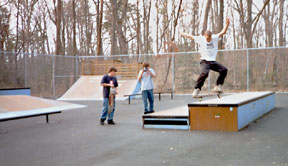|
Dock of the Bay
One Bear Crosses Over
The life and death of a criminal black bear
As most of Maryland’s black bears shake off their winter sleep, one nonconformist put himself at the wrong place one time too many. The 350-pound adult male was euthanized after Maryland Department of Natural Resources determined that the marauding bear was incorrigible.
Peaceful coexistence between bears and humans in Maryland is a precarious balance akin to the 20th century Cold War. Rules preserve the balance.
First among those rules is predictable behavior. That’s on the part of bears. Several hundred at best count live in Western Maryland, where density is calculated at 29 bears per hundred square miles.
Late winter into March, bears are supposed to be tucked in their dens. Bear sleep isn’t deep like the sleep of “true hibernators” — ground squirrels and chipmunks — says Paul Peditto, DNR’s director of Wildlife and Heritage Service. But bears are in a drowse so deep that humans can steal into their dens and knock them out with tranquilizers.
Peditto and his Western Maryland team of rangers have done just that in recent weeks.
“They were aware of our presence, awake, looking right at us,” said Peditto.
 |
photo courtesy of DNR
This bear had grown skillful at raiding dumpsters and had been trapped and relocated while in Pennsylvania earlier. After a goat killing, two pet rabbit killings and no apparent fear of dogs or humans, DNR put the bruin down. |
To avoid becoming bear bait, Peditto explains, “we try to work a strategy where we catch them from the backside. Normally we can get a tranquilizer dart in before they change their mind about having us around. Then we have 45 minutes.”
The purpose of these dangerous visits is keeping bears predictable. In the short safety zone, rangers tag the ears of cubs, which average four to a den. Eleven sows, as mother bears are termed, have been fitted with radio collars. Sometimes the big bears are carried from the den on stretchers for examination.
The renegade bear was not playing by these rules. Not only was he awake, he was alert and roaming. Worse, he was a steady traveler.
This was a Pennsylvania cub, according to his ear tag, and records showed him active there after he was shoved out of the den as a yearling. He’d seen quite a lot of his native state, having been relocated from Bucks County some 100 miles away.
Now he was at least 120 miles down the Susquehanna colonizing Maryland. He made the Connowingo Reservoir his territory, swimming back and forth between Harford and Cecil counties.
More troubling than his traveling ways was his behavior.
Bears are omnivores, and they awaken from hibernation hungry. Most bears fill up on fruit and berries, leftover acorns and hickory nuts, insects, invertebrates, buds and early leafy plants.
This bear preferred dumpsters, and he’d gotten skillful at raiding them. Worse, he had acquired a taste for warm meat. He’d been moved in Pennsylvania after killing a goat. Now in Maryland, he’d made two feasts of rabbits in hutches.
All that is behavior bad enough to get a bear deported. This one had been trapped before and wasn’t having any more of that, DNR found on setting out traps. He was wary enough to ignore a trap baited with what Peditto called “bear-friendly foods,” preferring to dine from an adjacent dumpster.
The bear broke the final rule when he crossed the fear barrier. He was indifferent to barking dogs and careless of humans.
“In the end, when we added up all the facts — a goat killing and documented human safety concerns in Pennsylvania, and two pet rabbit killings in Maryland and multiple occasions showing lack of appropriate fear of humans and dogs — the only responsible decision was to not put this bear back in the landscape,” Peditto said.
So Maryland begins this bear spring with one less bear.
Despite the likely opening of a bear-hunting season this fall to cull some 30 bears from Maryland’s several hundred, the life-taking is both rare and, Peditto says, mourned.
This was the second bear in the eight years that had “failed our policy test,” in Peditto’s words.
“It was a hard decision for us to make and the staff carry out,” Peditto said. “These are people who live and work with bears every day.”
—SOM
to the top
 Ask the Plant & Pest Professor Ask the Plant & Pest Professor
Q A partially shaded portion of my backyard is slowly turning from grass to moss. What can I add to the soil to reverse this transition?
A Moss indicates poor growing conditions such as: low pH, too much shade, poor drainage, compacted soil and low soil fertility. These conditions must be altered and good lawn care practices introduced or moss will continue. Moss can be raked up or chemically treated, but this is a temporary solution.
Test your soil to learn its pH and fertility. Test results will give liming and fertilization recommendations. Because the University of Maryland soil testing lab is now closed, we provide a list of regional soil testing labs, along with our many publications on lawn care, including moss control, on our website or toll-free hotline.
Fine fescue will tolerate more shade than tall fescue, the recommended seed for Maryland lawns. However, unless you have three to four hours of sunlight, you cannot grow grass. Consider using mulch or groundcover. Some people grow moss as a beautiful, velvety groundcover, with the added benefit of its being native.
Ask the Plant and Pest Professor is compiled from questions sent to the website of the Home and Garden Information Center, part of Maryland Cooperative Extension, an educational outreach of the University of Maryland. Ask a home gardening or pest control question and find other help: 800-342-2507 (Mon.-Fri. 8am-1pm) • www.hgic.umd.edu.
to the top
Lockdown at Truxtun Park
‘Foul language’ cuts skateboard park to 10 hours a week
“Cops would yell at us for skating downtown and not coming here, but then it wasn’t open so we couldn’t skate,” says Jonathan Brown, 15, in the skate park at Truxtun Park in Annapolis. “The times you’re able to skate on it … They don’t understand. Sometimes it’s locked.”
That situation won’t get any better in the near future, with the skate park’s open times newly cut back to just 10 hours a week: noon to five on Saturdays and Sundays, weather permitting.
After being open only for supervised use and for limited hours during its first year, the skate park was opened full time for unsupervised use on January 1, according to LeeAnn Plumer, recreation and parks director for the city.
“Some teens there have been taking advantage of being unsupervised. Most of the behavior is due to language. We want to get that under control,” says Plumer. “We got some reports of people blasting music that had foul language in it, which influences the younger participants. So we’re closing it except for supervised use until further notice.”
 |
photo by Lucy Oppenheim
Matt Owens and Kyle Ramsden watch Jonathan Brown at Truxtun Park skateboard park in Annapolis. |
Plumer does not expect this change to be permanent. “Our hope is to be able to open for longer hours as late spring and summer arrive,” she told Bay Weekly. “Our goal is to have it open as much as possible to serve as many people as possible.”
That goal may not be as simple as it sounds. Skaters in their teens, skaters in their 30s and parents teaching small children to skate may all want different environments in the same skate park. Even skaters close in age may see the park differently.
“I skate everywhere. I try to skate every day,” says Kyle Ramsden, 16. “I come here once, sometimes twice a week. We go downtown, hang out for a little bit, then come here ’cause we get kicked out by the cops.”
At the park for the first time, Ramsden’s brother, Matt Owens, 14, said “It’s awesome. It helps kids not get in trouble on the skateboards, with cops and stuff.”
Brown, skating with them, is more critical: “It’s better than nothing,” says the 15-year-old. “But I’d like a little more space, different obstacles. It gets old, the same thing over and over again.”
“That we have a park” is what Brown likes best about it.
The Truxton Park skateboard park is not perfect, skaters agree, but it’s the best they’ve got: In Rei’s words, “It’s a place where you can skate and not worry about cops, like in street skating.”
Now a locked gate greets weekday afternoon skaters like these.
“We want to monitor it for a couple weeks and see what the participation level is, see how many people use it and how many requests for extended hours we get,” Plumer says.
Her office is fielding requests at 410-263-7958, weekdays from 8:30am to 4:30pm or on the answering machine after hours.
Meanwhile, the skating community is negotiating for longer hours. Nihilism skateboard-wear owner Brian Harris says he’s gotten approval from the city parks department to hire private supervisors “to staff the park so it can stay open longer.” Annapolis Recreation and Parks could not confirm those talks.
By contrast, Queen Anne’s County’s skateboard park reopens for longer hours and, for the first time in its two-year life, with no monitor.
— Lucy Oppenheim
to the top
Second Chances on Too Much Fun
Commander Cody rocks Museum; Raitt, Haggard and more to follow
Just when Bill Kirchen’s departure from Chesapeake Country — where the Wammy-winning guitarist lived quietly while playing raucously for close to two decades — left rockabilly-lovers fearing we’d never have too much fun, his golden-age bandleader, Commander Cody, stopped by Calvert Marine Museum to give 100 or so fans another chance.
Too Much Fun is the signature song of the sexagenarian keyboardist and his Lost Planet Airmen, who Billboard Magazine named the World’s Greatest Live Band in 1974 and 1975. Those were the days when Kirchen, who still plays that song and many another Commander Cody favorites, was the Airmen’s lead guitarist. Kirchen has moved from Calvert County to Austin, Texas. The commander is older and his airmen fewer, but they still push their music about as close as you can get, short of going to jail, to having too much fun.
“I’ve invested well,” Cody told Bay Weekly. “I wouldn’t be doing this if I wasn’t having fun.”
 From the opening challenge — “There’s lots of things I’ve never done, but I ain’t never had too much fun” — through 19 songs to the encore “I Think I’m Going to Lose It Tonight,” the Lost Planet quartet celebrated music’s liberating, lawless power. From boogie-woogie to Western swing to rockabilly to rock ’n’ roll, Cody and his sweating Airmen played fast, funky and often funny. From the opening challenge — “There’s lots of things I’ve never done, but I ain’t never had too much fun” — through 19 songs to the encore “I Think I’m Going to Lose It Tonight,” the Lost Planet quartet celebrated music’s liberating, lawless power. From boogie-woogie to Western swing to rockabilly to rock ’n’ roll, Cody and his sweating Airmen played fast, funky and often funny.
“Most of these songs were written 30 years ago,” said Cody, but their virtuosity, wit and story lines make them as much fun when you didn’t know where that famous “Hot Rod Lincoln” was going to take you.
Fun is what Vanessa Gill has in mind in booking the six or seven acts that make up Calvert Marine Museum’s concert year. “We try to appeal to as many people in Southern Maryland as possible,” Gill says, “mixing it up with country or blues and rock.”
Cody was the second of this year’s four auditorium concerts. On Valentines Day, Leroy Thomas and the Zydeco Road Runners transported the audience from Bayside to Bayou with an exultant performance of Louisiana-laced rhythms.
Come June, the Waterside series moves outdoors, turning the museum campus into festival grounds. On June 5, nine-time Grammy winner Bonnie Raitt serves the fun. On July 18, fun is Merle Haggard’s responsibility. A third summer concert is planned but not yet booked for August or early September.
All this fun makes Calvert Marine Museum Southern Maryland’s biggest concert producer. The popular series has earned hundreds of thousands of dollars for the Museum, which gets two-thirds of its funding from Calvert County but must earn the other third. Over 18 years, the Museum has met that challenge by forcing audiences to have too much fun.
—SOM w/Gary Pendleton
to the top
Way Downstream …
Virginia, like Maryland, decided last week not to impose new crabbing restrictions — despite one of the worst harvests in history in 2003. The new plan extends a freeze on new crabbing licenses for three years and allows watermen to work an extra hour every day this spring in return for taking a week off in November…
In California, don’t even think about flippin’ your butt off Santa Monica Pier onto the beach, that famed movie spot. An ordinance adopted last week bans smoking not just on the pier but along a 13-mile stretch of beach, a jogging mecca for beautiful people and Hollywood stars…
In Australia, soon a third of the famed Great Barrier Reef Marine Park — nearly as big as Germany — will be off limits to fishing and shipping starting in July under a new law with teeth. How sharp are those teeth? Companies face a $1 million fine and individuals more than $200,000…
 Our Creature Feature comes from Thailand where, if you dare, you can obtain a menagerie of deadly snakes. They belonged to a fellow named Boonreung Buachan, who won’t be setting any more records for the Guinness Book. Our Creature Feature comes from Thailand where, if you dare, you can obtain a menagerie of deadly snakes. They belonged to a fellow named Boonreung Buachan, who won’t be setting any more records for the Guinness Book.
Buachan, known as ‘Snake Man’ for holding the world record for hanging out with deadly snakes, died at the fangs of a cobra last week north of Bangkok. He leaves behind 30 snakes, and nobody in his family will deal with them. Most likely they’ll go to a zoo, his father said.
|





 From the opening challenge — “There’s lots of things I’ve never done, but I ain’t never had too much fun” — through 19 songs to the encore “I Think I’m Going to Lose It Tonight,” the Lost Planet quartet celebrated music’s liberating, lawless power. From boogie-woogie to Western swing to rockabilly to rock ’n’ roll, Cody and his sweating Airmen played fast, funky and often funny.
From the opening challenge — “There’s lots of things I’ve never done, but I ain’t never had too much fun” — through 19 songs to the encore “I Think I’m Going to Lose It Tonight,” the Lost Planet quartet celebrated music’s liberating, lawless power. From boogie-woogie to Western swing to rockabilly to rock ’n’ roll, Cody and his sweating Airmen played fast, funky and often funny. Our Creature Feature comes from Thailand where, if you dare, you can obtain a menagerie of deadly snakes. They belonged to a fellow named Boonreung Buachan, who won’t be setting any more records for the Guinness Book.
Our Creature Feature comes from Thailand where, if you dare, you can obtain a menagerie of deadly snakes. They belonged to a fellow named Boonreung Buachan, who won’t be setting any more records for the Guinness Book.